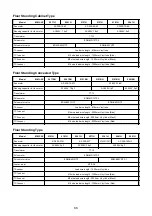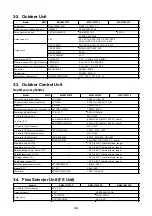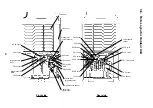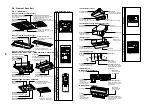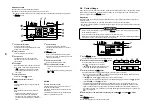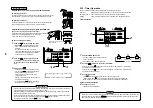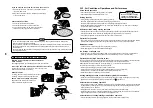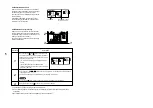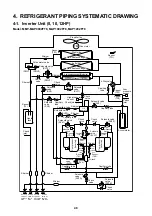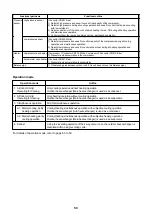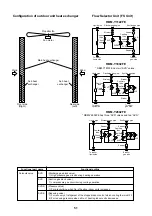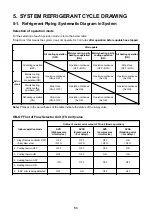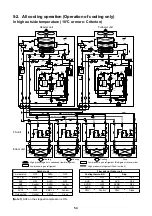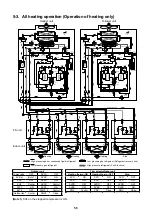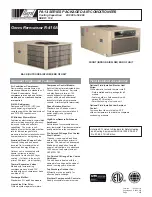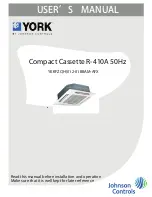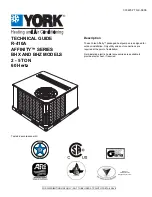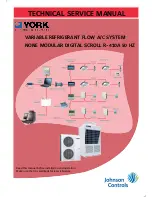
46
Air conditioner operating conditions
For specified performance, operate the air conditioner under the following temperature conditions:
3-14. Re-Installation
DANGER
If the unit position is to be changed and re-located to a new position ask your local dealer or
installation specialist. Do not attempt to move the air conditioner yourself, as incorrect installation
may cause electric shock or fire.
Do not install the air conditioner in the following places
• Do not install the air conditioner in any place within 1 m from a TV, stereo or radio set. If the unit is installed in
such places, noise transmitted from the air conditioner may affect the operation of these appliances.
• Do not install the air conditioner near a high frequency appliance (sewing machine or massager for business
use, etc.), as the air conditioner may malfunction.
• Do not install the air conditioner in a humid or oily place, or in a place where steam, soot or corrosive gas maybe
generated.
• Do not install the air conditioner in a salty place such as a seaside area.
• Do not install the air conditioner in a place where a great deal of machine oil is used.
• Do not install the air conditioner in a place where it is usually exposed to strong change winds such as in a
seaside area or on the roof / upper floor of a building.
• Do not install the air conditioner in a place where sulfureous gas maybe generated such as in a spa.
• Do not install the air conditioner in a vessel or mobile crane.
Be careful with noise or vibrations
• Do not install the air conditioner in a place where the noise or the hot air
created by the outdoor unit will come into contact with your neighbours.
• Install the air conditioner on a solid and stable foundation as this will reduce
the transmission of noise and vibration that is produced from the outdoor unit.
• If one indoor unit is operating, some sound may be audible from other indoor
units that are connected within the same system (even when not in operation)
Cooling operation
Heating operation
Outdoor temperature : –10°C to 43°C (Dry-bulb temp.)
Room temperature
: 21°C to 32°C (Dry-bulb temp.), 15°C to 24°C (Wet-bulb temp.)
CAUTION
Room relative humidity – less than 80 %. If the air conditioner operates
in excess of this figure, the surface of the air conditioner may cause dewing.
Outdoor temperature : –15°C to 21°C (Dry-bulb temp.), –15°C to 15.5°C (Wet-bulb temp.)
Room temperature
: 15°C to 28°C (Dry-bulb temp.)
• If the air conditioner is used outside of the above conditions, the units safety protection devices may operate.
* Do not use “Super HRM” for other than personal usage where the ambient temperature may go down below
–5°C. (For example, OA equipment/Electric device/Food/Animals and plants/Art object)
CAUTION
When outdoor temperature goes out of specified range, “
or
” mark is indicated on the Wired remote
controller display and the required operation will stop.
“
&
” : When in heating operation. “
” : When in cooling operation.
Notice :
• This indication is not failure.
• When outdoor temperature goes back to specified range, “
or
” will disappear and the unit will begin
normal operation.
• The unit operation may stop if the next operation (request) cannot be fulfilled because it falls outside the
specification for Super HRM. See below for the maximum cooling and heating specifications.
(Outdoor temp. (DB) < –10°C : Cooling mode, > 21°C : Heating mode)
Silent
It’s strange.
3-15. When the Following Symptoms are Found
Check the points described below before contacting your local service repair center.
Symptom
Outdoor unit
• White misty cold air or
water is blown out.
• Sometimes, the noise
“Pushu !” is heard.
Indoor unit
• “Swish” sound is
sometimes heard.
• Slight “Pishi!” sound is
heard.
• Discharge air smells.
• “
” indication is lit.
• Sound or cool air is
blown from the
indoor unit.
• When power of the air
conditioner is turned
on, “Ticktock” sound is
heard.
Operates or stops automatically.
Does not operate.
Air is not cooled or warmed sufficiently.
Cause
• The fan on the outdoor unit automatically stops when
performing a defrost operation.
• Solenoid valve works when defrost operation starts and
finishes.
• When the unit is in operation,a sound such as the movement
of water from one area to another may be heard. This sound
may become larger after a period of 2 to 3 minutes once the
unit has begun operation. This is not a cause for concern,
but is the movement of the refrigerant or the draining sound
of the dehumidifier.
• This is sound generated when the heat exchanger, etc.
expands and contracts slightly due to the change of tem-
perature.
• Various odurs such as those from a carpet, clothes, ciga-
rette, or cosmetics will adhere to the air conditioner.
• Has the outdoor temperature gone out of its specified range
specified range?
• When the manager of the air conditioner has fixed the
operation to either COOL or HEAT, but a request/demand
contrary to this setup operation is requested.
• When the fan operation is stopped to prevent the discharge
of hot air.
• Since refrigerant is flowed temporarily to prevent the stay of
oil or refrigerant in the stand by indoor unit, the sound of
flowing refrigerant, “Kyururu” or “Shaa” may be heard.
When indoor unit operates in HEAT mode, and cold air in
COOL mode white steam may be blown out.
• Sound is generated when the expansion valve operates
when power supply has been turned on.
• Is the timer “ON” or “OFF”?
• Is there a power failure to the unit?
• Has the power supply been turned off?
• Has the power fuse or breaker blown?
• Has the protective device operated?
(The operation lamp goes on.)
• Is the timer “ON”? (The operation lamp goes on.)
• Has the outdoor temperature gone out of the specified range
for the outdoor unit?
• Is the suction port or discharge port of the outdoor unit
obstructed?
• Are there any doors or windows open?
• Is the air filter clogged with dust?
• Is the discharge louver of the indoor unit set at appropriate
position?
• Is the air selection set to “LOW” or “MED” and is the opera-
tion mode set to “FAN Only”?
• Is the setup temp. the appropriate temperature?
• Has the outdoor temperature gone out of the specified range?
It is not a failure
.
Chec
k a
gain.
When the following symptoms are found, stop the unit operation immediately, turn off the power supply, and contact the
dealer from where you have purchased the air conditioner.
• Activation of the power supply causing the unit to operate in an unstable fashion (power on, power off, power on,
power off etc).
• The main power fuse often blows out, or circuit breaker is often activated.
• Foreign matters or water have entered the unit by mistake.
• When the unit fails to operate after the protective device (circuit breaker) has been removed. Not recommended.
• Other unexplained symptoms or unit abnormalities, that cannot be explained.


